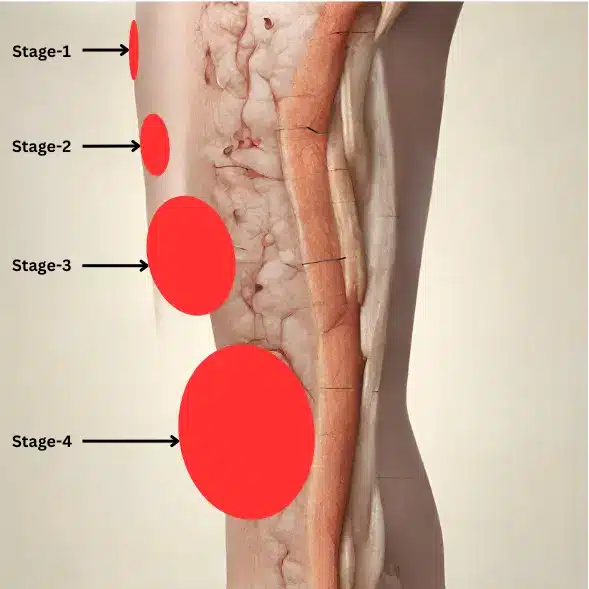What is decubitus ulcer?
Decubitus ulcers, also known as pressure ulcers or bedsores, are a type of injury that affects areas of the skin and underlying tissue.
These injuries are a result of prolonged pressure on the skin, most often occurring in individuals who are bedridden or unable to move for extended periods.
The primary areas of the body affected by decubitus ulcers are those over bony prominences, such as the heels, hips, elbows, or tailbone, where the skin and underlying tissues are compressed between hard bones and a surface like a bed or a wheelchair.
The development of a decubitus ulcer is not only painful but can also lead to severe complications if not treated properly. The severity of these ulcers can range from a mild redness of the skin to severe tissue damage that extends into muscle and bone.
In extreme cases, untreated decubitus ulcers can lead to life-threatening infections.
The risk factors for decubitus ulcer development include immobility, advanced age, malnutrition, and certain medical conditions that affect blood flow such as diabetes and vascular diseases.
Therefore, it is crucial to provide proper care to individuals who are at high risk. This can include regular repositioning in bed or wheelchair, maintaining good nutrition and hydration, and keeping the skin clean and dry.
Prevention is considered the best approach when it comes to decubitus ulcers. Health professionals should be diligent in identifying patients at risk and implementing strategies to reduce pressure on vulnerable areas of the body. By doing so, they can significantly reduce the incidence rate of these debilitating injuries.
What are the causes of decubitus ulcers?
The most common cause of decubitus ulcers is sustained pressure. When constant pressure is applied to certain parts of the body, especially those over bony areas, it can lead to reduced blood supply to those areas.
This reduction in blood flow can cause the skin and underlying tissues to become starved of oxygen and vital nutrients, leading to cell death and the development of ulcers. This is generally observed in individuals who are bedridden or use a wheelchair for extended periods.

- Shear is another significant cause of decubitus ulcers. Tissue damage can occur when the skin moves in one direction while the underlying bone forces in the opposite direction. This can cause damage to the blood vessels and tissues, potentially leading to ulcer formation. For instance, if an individual is sitting in bed at an angle, the skin over the tailbone might stay in place while gravity pulls down on the skeleton, creating a shearing effect on the tissue in between.
- Lastly, friction can also contribute to the development of decubitus ulcers. When skin is dragged against bedding or a wheelchair, it may become damaged and more susceptible to breakdown, particularly in individuals with poor circulation or malnutrition.
What is the mechanism of pressure ulcer formation?
The physiology of pressure ulcers is complex and multifaceted, involving several interrelated physical and biological processes.

Another critical aspect of pressure ulcers involves the role of shear forces and friction. When the skin is subject to friction or shear stress, it can cause the protective stratum corneum layer to deteriorate or become damaged. This can lead to further skin breakdown and the development of ulcers.
The presence of moisture from sweat or incontinence can also contribute to the development of pressure ulcers by making the skin more susceptible to damage and by providing a conducive environment for microbial growth. This can lead to infection, which further complicates the physiological process of wound healing.
The physiology of pressure ulcers is a complex interplay of mechanical forces and biological responses. Understanding these physiological processes is crucial for effective prevention and treatment of pressure ulcers.
What are the major risk factors for pressure injuries?
Several risk factors increase an individual’s likelihood of developing pressure ulcers.

A comprehensive understanding of these factors is crucial in preventing and managing this debilitating condition. By addressing these risk factors proactively, healthcare providers can help reduce the incidence and severity of pressure ulcers in at-risk populations.
Read about: A Comprehensive Guide to Gordon’s Functional Health Patterns: Exploring 11 patterns
What are the 4 stages of pressure ulcers?
The stages and characteristics of pressure ulcers can be categorized into four distinct phases.

Understanding the stages and characteristics of pressure ulcers is crucial for prevention and treatment. It’s important to note that each stage presents unique characteristics that require specific management and care procedures to promote healing and prevent further complications.
What is the primary treatment of a pressure ulcer?
The treatment for decubitus ulcers primarily involves reducing pressure on the area, promoting wound healing, and preventing infection.

The treatment options for decubitus ulcers are multifaceted and tailored to individual patient needs. It typically involves a combination of pressure relief, wound care, antibiotics when necessary, nutritional support, and possibly surgery.
Read about: 6 Ethical Principles in Nursing-Nursing Ethical and Legal Issues
Nursing interventions to prevent pressure ulcers
With the appropriate nursing interventions, the risk of developing pressure ulcers can be significantly reduced.

What is the fastest way to cure bed sores at home?
With careful management at home, it is often possible to prevent and treat bed sores.
- The first step in bed sore management at home involves consistent repositioning. Whether the individual is in a bed or a wheelchair, they must move as frequently as possible to alleviate pressure on vulnerable areas. For individuals who cannot move independently, caregivers should assist with repositioning every two hours. Using pillows or foam wedges to support different areas of the body can also help distribute pressure evenly.
- In addition to regular movement and repositioning, maintaining skin health is vital in the management of bed sores. This includes keeping the skin clean and dry, as moisture can exacerbate the condition. Using mild soaps and warm (not hot) water can prevent irritation, and applying moisturizers can prevent dryness.
- Nutrition also plays a significant role in bed sore management at home. Providing a diet rich in protein, vitamins, and minerals can promote skin health and aid in wound healing. It may be beneficial to consult with a dietitian or healthcare provider to ensure the individual is receiving adequate nutrition.
- Lastly, it’s important to regularly inspect the skin for signs of sores. Early detection is a key factor in preventing further progression and facilitating healing. If a bed sore does develop, it’s crucial to seek medical attention promptly to avoid complications.
Managing bed sores at home may require diligence and patience, but it’s possible with regular movement, proper skin care, a balanced diet, and vigilant monitoring.
It’s always recommended to consult with healthcare professionals for personalized advice based on individual needs.
Support surfaces for pressure ulcer prevention
The use of supporting devices plays a crucial role in preventing and treating pressure ulcers Supporting devices like specialized mattresses or cushions work by redistributing the pressure over a larger area, thereby reducing the risk of skin breakdown.
They come in various forms including foam, gel, air-filled, and water-filled. These devices mold to the body’s shape, helping to minimize pressure points on vulnerable areas such as the heels, hips, and tailbone.
Regular repositioning is also recommended as part of a comprehensive approach to pressure ulcer prevention, and there are supporting devices designed to assist with this as well.

For individuals confined to a wheelchair, pressure-relieving cushions are an essential supporting device. These cushions are designed to distribute the user’s weight more evenly and reduce the strain on any one area. Similarly, heel protectors can provide relief for individuals who spend long periods lying down.
In addition to physical supporting devices, certain technological solutions can also aid in pressure ulcer prevention and treatment. For example, sensor technology can monitor pressure distribution and alert caregivers when repositioning is needed.
While these supporting devices are effective tools in both the prevention and management of pressure ulcers, they should be used as part of a broader strategy that includes regular skin assessment, good nutrition, and appropriate skin care.
It’s also important to remember that while these devices can significantly help reduce the risk of developing pressure ulcers, they don’t eliminate the risk. Regular repositioning and movement remain key aspects of effective pressure ulcer prevention and treatment strategies.
Read about: A comprehensive guide to Next Generation NCLEX (NGN)
Conclusion: Taking proactive steps to prevent and treat decubitus ulcers
Decubitus ulcers can have a significant impact on the health and well-being of individuals, particularly those who are bedridden or have limited mobility.
By understanding the causes, risk factors, and stages of pressure ulcers, healthcare professionals and caregivers can take proactive steps to prevent their development and provide effective treatment.
Regular repositioning, proper nutrition, and good hygiene are essential in preventing the formation of bedsores. Additionally, early identification and appropriate medical interventions can promote healing and prevent further complications. By implementing these strategies, individuals at risk can maintain optimal skin health and overall well-being.
Read about: Mastering the NCLEX-RN Exam: A Comprehensive Guide 3 elements of success
References:
- Bickley, L. S., Szilagyi, P. G., & Bates, B. (2013a). Bates’ Guide to Physical Examination and history taking. Wolters Kluwer Health / Lippincott Williams & Wilkins.
- Berman, A., Snyder, S. J., Frandsen, G., & Kozier, B. (2022). Kozier & Erb’s fundamentals of nursing: Concepts, process, and Practice. Pearson Education Limited.
- Potter, P. A., Perry, A. G., Stockert, P. A., & Hall, A. (2019a). Essentials for nursing practice. Elsevier.
- Carpenito-Moyet, L. J. (2009). Nursing care plans and documentation: Nursing diagnoses and collaborative problems. Lippincott Williams and Wilkins (LWW).
- Mayo Foundation for Medical Education and Research. (2023, May 13). Bedsores (pressure ulcers). Mayo Clinic. https://www.mayoclinic.org/diseases-conditions/bed-sores/symptoms-causes/syc-20355893
- DeLaune, S. C., & Ladner, P. K. (2002). Fundamentals of Nursing: Standards & Practice. Delmar Thomson Learning.
- Bedsores. Johns Hopkins Medicine. (2021, August 8). https://www.hopkinsmedicine.org/health/conditions-and-diseases/bedsores
- Causes and prevention of pressure sores. Coping with cancer | Cancer Research UK. (2024, January 10). https://www.cancerresearchuk.org/about-cancer/coping/physically/skin-problems/pressure-sores/causes-and-prevention
- NHS. (n.d.). NHS choices. https://www.nhs.uk/conditions/pressure-sores/